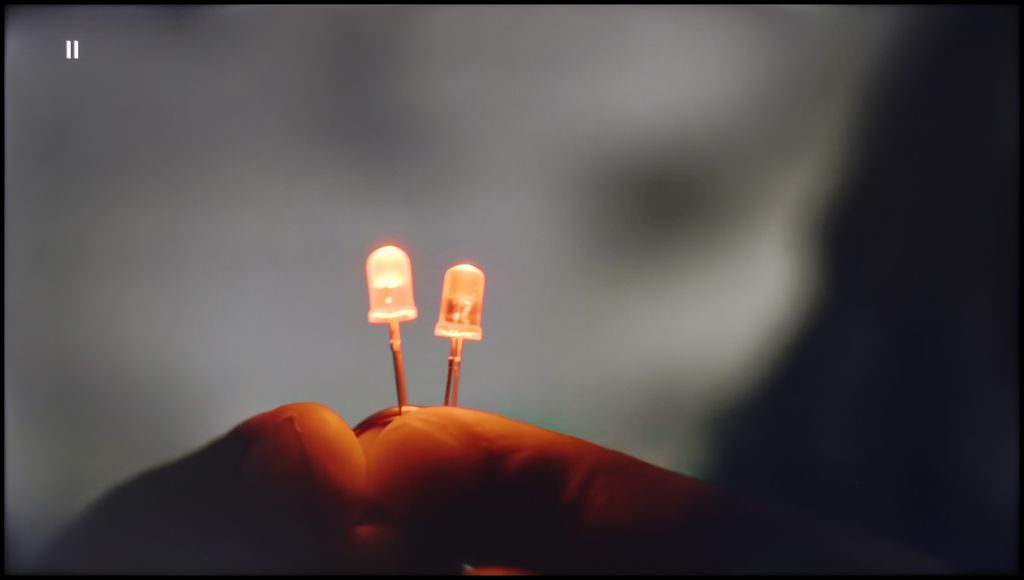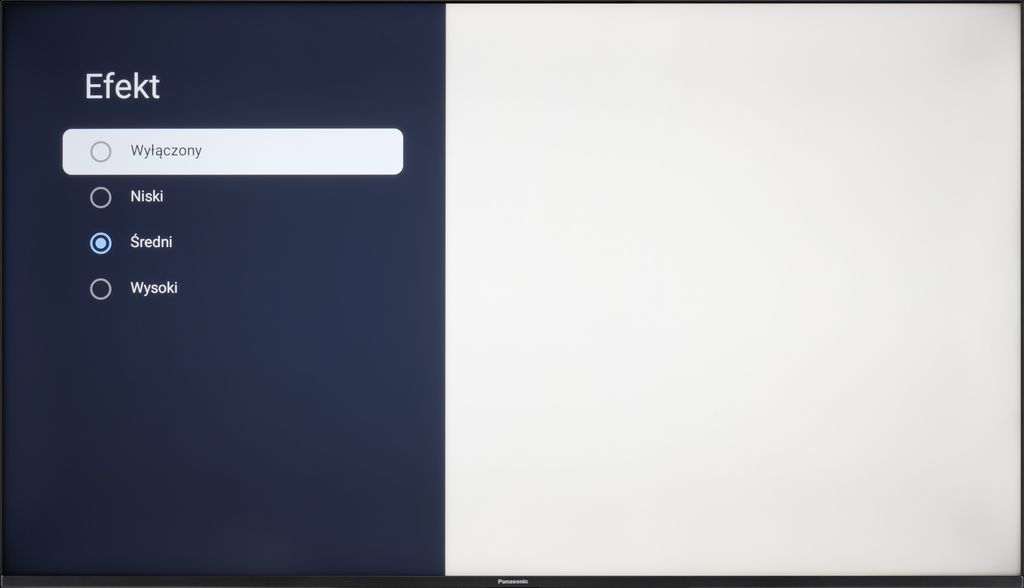- Matching (Score)
- Our verdict
- Competing TVs
- TV appearance
- Where to buy
- Contrast and black detail
- HDR effect quality
- Factory color reproduction
- Color reproduction after calibration
- Smoothness of tonal transitions
- Image scaling and smoothness of tonal transitions
- Blur and motion smoothness
- Console compatibility and gaming features
- Input lag
- Compatibility with PC
- Viewing angles
- Daytime performance
- TV features
- Apps
- Playing files from USB
- Sound
- Panel details
Panasonic W70A Review
Available screen sizes:

Complete the survey to find out the result
Panel type: LCD IPS Refresh rate: 60Hz Brand: PANASONIC Resolution: 3840x2160 System: Google TV Model year: 2024
PANASONIC W70 - Our verdict
5.6
Overall rating
The Panasonic W70A primarily draws attention with its extensive Google TV operating system, which gives us access to a myriad of popular applications (YouTube, Netflix, Disney+, HBO Max, etc.). When it comes to the picture, the IPS matrix offers wide viewing angles, so colors do not lose intensity even when you watch a movie slightly off to the side. Gamers won't be disappointed either; we have VRR and ALLM here, as well as low input lag (around 12 ms) – all of this translates to a pleasant experience for occasional gaming, despite the standard 60 Hz refresh rate.
However, it is worth remembering that this is rather a basic model and has its limitations. The contrast and black levels are simply poor, which is a typical phenomenon for IPS matrices, especially in dark rooms. Brightness at around 270 cd/m² is also insufficient in heavily sunlit rooms, so the picture may seem washed out then. Additionally, certain shortcomings in the software cannot be overlooked. Google TV is a great foundation, but some settings are scattered in surprising places, and the quality of translations leaves much to be desired.
One must consider that the competition is offering more and more in a similar (or only slightly higher) price range. Can the Panasonic W70A hold its ground in such an environment? On one hand, it tempts with a rich application base and decent support for gamers, but on the other hand, the market is flooded with more polished TVs equipped with better parameters. However, if wide viewing angles and straightforward access to Google TV services are priorities, we can give it a chance. Otherwise, it is worth exploring competitive models that often offer better black levels, higher brightness, and fewer annoying menu issues for a similar price.
Advantages
Wide viewing angles thanks to the IPS matrix
Efficient and intuitive Google TV system
Support for Dolby Vision
Suitable for occasional gaming - VRR, ALLM, low input lag of 12 ms
Readable fonts when working with PC thanks to chroma 4:4:4
Bluetooth and voice search on the remote
Decent sound quality for a TV in this class
Disadvantages
Poor black levels and low contrast - IPS matrix
Brightness at 270 cd/m² is too low for comfortable viewing in a bright room
Software errors (features are either poorly translated or located where they shouldn't be)*
No AirPlay support
No USB recording function and PIP mode
*This situation refers to the time of publication of this review, which is December 2024. We hope that Panasonic will manage to improve these significant shortcomings in future updates.
Movies and series in UHD quality
5.2
Classic TV, YouTube
5.2
Sports broadcasts (TV and apps)
5.3
Gaming on console
6.8
TV as a computer monitor
6.0
Watching in bright light
4.0
Utility functions
5.2
Apps
8.3
Sound quality
6.6
Complete the survey to find out what fits your preferences
PANASONIC W70 - Competing TVs in this price range
PANASONIC W70 - TV appearance
HDMI inputs: 3 x HDMI 2.0, 0 x HDMI 2.1 Outputs: Toslink (Optical audio), eARC (HDMI), ARC (HDMI), Mini-Jack (Headphones) Network Interfaces: Wi-Fi 2.4GHz, Wi-Fi 5GHz, Ethernet (LAN) 100Mbps
Build quality: Average
Stand type: Central
Bezel color: Black








Stand: Fixed
Flat design: No
Accessories: Stand
Buy at the best price
Select size:
PANASONIC W70 - Contrast and black detail
2.5/10
Local dimming function: No

Result
1,100:1

Result
1,250:1

Result
1,300:1

Result
1,250:1

Result
1,050:1
Visibility of details in the lights:

The Panasonic W70A is equipped with an IPS panel, which unfortunately is not the best choice if we care about deep blacks and high contrast. Additionally, the lack of local dimming means that instead of pitch-black areas on the screen, we see rather silvery and navy patches. In our tests, this was particularly noticeable in demanding scenes with dark visuals. The contrast ratio, which hovers around 1000:1, is far from satisfactory – especially if we plan to watch in a dimly lit room in the evening. Scenes that should hypnotize with the depth of darkness instead look flat and lose their atmosphere.
Halo effect and black detail visibility:
PANASONIC W70 - HDR effect quality
4.5/10
Supported formats: HDR10, Dolby Vision, HLG Color gamut coverage: DCI P3: 78.0%, Bt.2020: 57.0%
Luminance measurements in HDR:

Result
247 nit

Result
257 nit

Result
278 nit

Result
289 nit

Result
293 nit
HDR on the Panasonic W70A unfortunately does not impress. Brightness at the level of 250–300 nits is simply too low to feel the true magic of cinematic effects in dynamic, bright scenes. Images that should "explode" with light appear rather flat, and fine details in bright areas often get lost in the average luminance of the panel. On the positive side, the HDR effect is at least stable. The TV does not suffer from excessive brightening nor does it lose details during sudden scene changes. Everything is predictable and calm, though unfortunately not very spectacular. Another issue is the color gamut coverage. The W70A is not equipped with an additional layer of quantum dots (often known as QLED), resulting in colors appearing rather mediocre. There is a lack of depth in reds, saturation in greens, and precision in rendering subtle shades.
Scene from the movie “Pan” (about 2800 nits)

Scene from the movie “Billy Lynn” (about 1100 nits)

We checked how the Panasonic W70A performs in demanding HDR scenes where high-end TVs have the opportunity to showcase their full potential. Unfortunately, the initial tests revealed clear problems with brightness and detail management in extreme parts of the image. In the film Pan, where intense light sources appear on screen, the TV had significant difficulties maintaining details in the brightest areas. The sun on the horizon, instead of being a distinct point, spread out into a uniform patch of light. The scene with fireworks from Billy Lynn was somewhat better – the light effects looked decent, but the color consistency left much to be desired. Poor color gamut coverage made some shades look simply pale.
An interesting feature is the dynamic tone mapping, which in theory should help manage brightness and contrast in difficult scenes. However, in practice, it turned out that its activation does more harm than good – the image becomes unnatural, and details disappear in overly bright areas. Even more surprisingly, the dynamic tone mapping feature was only available in game mode, while HGiG – which should be a standard in games – was found in movie mode. This is a significant confusion in the TV's software, which clearly needs improvement. Perhaps Panasonic will fix this issue in future updates, but as of the testing date (December 2024), the situation looked like this, and we, out of journalistic duty, must mention it.
HDR luminance chart:
HDR luminance
The Panasonic W70A supports several popular HDR standards, including HDR10 and Dolby Vision. While the presence of Dolby Vision in a TV from this price segment is a big plus, it's hard to say that it fully delivers here. In Dolby Vision, the image indeed looks better than in HDR10. There are more details visible in the shadows, and the interplay of lights is more subtle and natural. Dynamic metadata manages brightness and contrast well in individual scenes, which allows for a more cohesive effect. Unfortunately, even Dolby Vision cannot overcome the limitations of the TV itself – primarily the low brightness of the panel (250-300 nits). The HDR effect, which is supposed to dazzle with the intensity of lights and depth of colors, is simply… decent here.
Static HDR10

Dynamic: Dolby Vision

Factory color reproduction
3.9/10
The Panasonic W70A was tested in movie mode, which theoretically should guarantee the most natural image reproduction. Unfortunately, as is often the case with budget televisions, the reality proved far from ideal.
In HD (SDR) content, the white balance was severely disrupted by an excess of red and a noticeable drop in blue tones. The result? The image had a distinctly warm, even yellowish tint, which is clearly visible in the comparison photo. In the case of 4K HDR materials, the situation reversed. Here, the image became excessively cold and bluish, causing scenes to lose their naturalness and depth. The differences are visible even to the naked eye, especially in the bright parts of the image. The Colour Checker palette test confirmed our observations. Most color samples did not hit their intended points, "running away" towards warmer shades in SDR and cooler ones in HDR. As for brightness characteristics, both gamma and the EOTF curve showed significant problems. The image tended to excessively brighten certain areas, disrupting the balance and leading to a loss of details in darker and brighter regions.
In summary – the factory color reproduction settings in the Panasonic W70A leave much to be desired. The image is far from neutral, and the errors in white balance and gamma mean that a solid calibration is needed to extract the full potential from this television.
Color reproduction after calibration
5.7/10
The Panasonic W70A, despite its limitations, gave us a lot of room to maneuver during calibration. Thanks to well-developed tools, we were able to achieve significantly better white balance in both HD (SDR) and 4K HDR content. The issues with excess red in SDR and overly cool images in HDR have disappeared. The gamma brightness characteristic has also improved, maintaining stability and avoiding excessive brightness or loss of detail in darker areas.
So where is the problem? Unfortunately, there are barriers that even professional calibration cannot overcome. Poor coverage of a wide color gamut means that the TV cannot fully reproduce colors in HDR materials. There is a lack of saturation, and subtle color transitions still appear somewhat "flattened." Another limitation is brightness management, which results from the use of an IPS panel. In the comparative photo featuring the actress's face in colorful clothing, it is clearly visible how some shades are noticeably muted, and colors lose their depth and brightness.
The calibration extracted everything it could from the W70A. The image is now much more natural, and the errors in the factory settings have been effectively corrected. Unfortunately, hardware limitations in the form of poor color gamut coverage and an average panel prevent us from achieving spectacular results, especially in HDR content.


PANASONIC W70 - Smoothness of tonal transitions
8.3/10
In terms of the smoothness of tonal transitions, the Panasonic W70A performs really well. The transitions between colors are smooth, without distinct and annoying "bands" or sudden jumps in hue. Even more demanding scenes, where subtle gradients dominate, look surprisingly good. Of course, a trained eye will notice some imperfections, especially in the brighter areas of the screen, where slight color blends can be observed. However, this is not something that significantly affects the perception of the image, and for most users, it will be practically unnoticeable.
Unfortunately, what detracts from the overall effect is the unevenness of the backlighting of the panel, which is quite pronounced and can distract from the quality of the tonal transitions themselves. This is particularly noticeable on uniform backgrounds, where differences in brightness between individual areas of the screen become more apparent.








Image scaling and smoothness of tonal transitions
7.8/10
Smooth transition function

Image without overscan on the SD signal

We checked how the Panasonic W70A performs in improving content of lower quality than 4K, and it must be admitted that the television does quite well in this regard. The "Zeroing Counter" function is responsible for smoothing tonal transitions. The optimal setting turned out to be the Average option, which effectively smooths out color gradation issues while not ruining the film grain. This is the setting we recommend for most users, as it provides a balance between improving the fluidity of transitions and maintaining the naturalness of the image.
As for image scaling, the Panasonic W70A performed really well. The test pattern with the model was positively evaluated – details on her clothing were well reproduced, and the contours of her face retained sharpness. In the background, we noticed slight "jaggies" on thin branches, but these are details that only a very observant eye will catch. However, it is worth noting a certain flaw of this model – the television has a tendency to overscan, which means slight cropping of the image edges. This is not a very intense phenomenon and for most users it will be practically unnoticeable, but if we care about perfect framing, it is worth keeping this in mind.
PANASONIC W70 - Blur and motion smoothness
4.7/10
Maximum refresh rate of the panel: 60Hz
Film motion smoothing option: Yes
Blur reduction option: No
BFI function 60Hz: No
BFI function 120Hz: No

The Panasonic W70A is equipped with a 60 Hz panel, which immediately suggests that the television will perform best when watching movies, series, or everyday TV content. In more dynamic scenes, such as sports broadcasts or games, the panel's limitations become more noticeable. On the positive side, it is worth noting the presence of a motion smoother called "Effect," which offers three levels of adjustment - low, medium, and high.
Each of the settings allows you to adjust motion fluidity to your own preferences, minimizing motion blur and improving clarity in dynamic shots. In practice, the Medium setting seems to be the most versatile - it offers better fluidity without excessive "soap opera effect," which can look artificial in feature films. The High setting may work well for sports broadcasts, but in films, it can disrupt the natural character of movement.
Blur (native resolution, maximum refresh rate):



Despite these options, the 60 Hz panel has its limitations, and the motion blur effect can be noticeable in more demanding sequences, especially with fast camera movement or dynamic action scenes.
PANASONIC W70 - Console compatibility and gaming features
6.2/10
ALLM: Yes
VRR: Yes
VRR range: 47 - 60Hz
Dolby Vision Game Mode: Yes
Correct implementation of HGIG: Yes
1080p@120Hz: No
1440p@120Hz: No
4K@120Hz: No
Game bar: No


The Panasonic W70A is a television that will be more suitable for occasional gamers than for avid players. The 60 Hz panel does not allow for full utilization of the potential of new generation consoles, especially in dynamic titles. The lack of HDMI 2.1 somewhat limits its capabilities, but fortunately, we find features such as ALLM, which is automatic switching to game mode, and VRR, which helps minimize screen tearing. It's also worth noting the support for Dolby Vision in games and HGiG, which makes HDR more predictable and looks solid. It's just a pity that the Game Bar is missing. This feature is already standard in many televisions and provides quick access to the most important settings for gamers. The W70A holds up when it comes to gaming, but it has its limitations. It works well with calmer titles, while more demanding players may feel unsatisfied.


PANASONIC W70 - Input lag
10/10
In terms of signal delay, the Panasonic W70A performs really well. A result of 12 ms is a value that is practically below the threshold where noticeable delay can be discussed. Gaming on this TV is responsive, and character movements or reactions in games are immediate. Interestingly, even in Dolby Vision mode, which often tends to be problematic in terms of input lag, the TV performed very well. This is a pleasant surprise, as many manufacturers have issues with this, and HDR often increases the delay to a level that is noticeable during fast-paced games.
| SDR | HDR | Dolby Vision |
|---|---|---|
| 1080p60: 12 ms | 2160p60: 12 ms | 2160p60 DV: 12 ms |
| 2160p60: 12 ms |

PANASONIC W70 - Compatibility with PC
6/10
Chroma 444 (maximum resolution and refresh rate): Yes
Font clarity: Very Good
Readability of dark text and shapes: Very Good
Input lag in PC mode (4K, maximum refresh rate): 12ms
Matrix subpixel arrangement: RGB
Max refresh rate: 60Hz
G-Sync: No
The Panasonic W70A performs quite well as a work monitor. Thanks to the IPS panel and 4:4:4 chroma support, text is clear, sharp, and legible. Even small fonts look good, without blurring or ragged edges. For office work, web browsing, or document writing, this TV is really suitable.
Playing on PC is a slightly different story. The 60 Hz panel makes more dynamic titles not look as smooth as they could on a higher refresh rate screen. The lack of G-Sync or FreeSync support doesn't help either, so there may be issues with image tearing.
PANASONIC W70 - Viewing angles
6.2/10
Brightness drop at an angle of 45 degrees: 69%
For a television with an IPS panel, the viewing angles on the Panasonic W70A are really good. The image maintains decent quality even when we look at the screen from a greater angle. The colors do not significantly lose saturation, and the details remain well visible. Of course, everything comes at a price. In this case, it is the weaker blacks that become even more washed out when viewed at an angle. However, this is a standard compromise for IPS panels and it is hard to consider it a surprise.
PANASONIC W70 - Daytime performance
4/10


Panel finish: Satin
Reflection suppression: Average
Black levels during daytime: Good
The Panasonic W70A is equipped with a satin display, which average handles light reflection suppression. Glare is not excessively bothersome, but in bright rooms, especially under direct sunlight, it can be noticeable. The main issue, however, is the brightness level of 270 cd/m². It's simply too low to comfortably watch television in full sunlight. The image becomes washed out, and darker scenes lose detail and depth.
Panel brightness
Average luminance SDR
Panasonic W70A: 272 cd/m2
PANASONIC W70 - TV features
5.2/10
System: Google TV
System performance: Average
- HDMI inputs: 3 x HDMI 2.0, 0 x HDMI 2.1
- Outputs: Toslink (Optical audio), eARC (HDMI), ARC (HDMI), Mini-Jack (Headphones)
- Network Interfaces: Wi-Fi 2.4GHz, Wi-Fi 5GHz, Ethernet (LAN) 100Mbps
- TV reception: DVB-T, DVB-T2, DVB-S, DVB-S2, DVB-C
Classic features:
Recording to USB (terrestrial TV): No
Recording programming: No
Picture in Picture (PiP): No
RF remote control (no need to aim at the screen): RF
Backlit remote control: No
Teletext: Yes
Audio only mode: Yes
Bluetooth headphones support: Yes
Simultaneous Bluetooth headphones & TV audio: No
Smart features:
AirPlay: No
Screen mirroring (Windows Miracast): Yes
Voice search: Yes
Voice search in native language: Yes
Ability to connect a keyboard and mouse: Yes




The Panasonic W70A runs on the Google TV system, and it must be admitted that this is one of its strong points. There are really many applications – all popular streaming services, YouTube, and even less known platforms. The system operates smoothly, and navigating through the menu is intuitive and trouble-free. The remote control has a built-in microphone, so you can use voice search in Polish. This is a significant convenience, especially when you need to find a movie or an app quickly. Additionally, there is Bluetooth, which allows you to connect headphones or other wireless devices. However, there are some shortcomings. There is no AirPlay, which may be an issue for users of Apple devices. There is also a lack of USB recording options and picture-in-picture (PIP) functionality.
The Panasonic W70A makes up for these shortcomings with the functionality of Google TV and simple operation. It has everything you need to use Smart TV, but if someone is counting on more elaborate options related to traditional television, they might feel some dissatisfaction.
Sound connection options
HDMI audio:
Other audio outputs:
Toslink: Yes
Stereo (Mini-Jack): Yes
Wireless audio:
Bluetooth: Yes
Supported audio formats (external HDMI eARC audio):
Dolby Digital Plus 7.1: Yes
Dolby True HD 7.1: No
Dolby Atmos in Dolby Digital Plus (JOC): Yes
Dolby Atmos in Dolby True HD: No
DTS:X in DTS-HD MA: No
DTS-HD Master Audio: No
Senior accessibility
Numeric keyboard on TV: Yes
Font size adjustment: No
Audio description: No
PANASONIC W70 - Apps
8.3/10























PANASONIC W70 - Playing files from USB
7.7/10

| Maximum photo resolution: | Supported photo formats: |
|---|---|
The built-in media player in Panasonic W70A unfortunately has its limitations. Primarily, it does not support Polish subtitles, which can be a significant problem for many people. Additionally, there are difficulties with playing certain file formats, which sometimes results in an error message or a lack of sound.
Fortunately, thanks to the Google TV system, alternative media players can be easily installed that address these shortcomings. In the Google Play Store, we can find several reliable applications that support both Polish subtitles and less popular video formats.
PANASONIC W70 - Sound
6.6/10
-
Maximum volume
Supported codecs
(TV speakers)
Dolby Digital Plus 7.1
Dolby True HD 7.1
Dolby Atmos in Dolby Digital Plus (JOC)
Dolby Atmos in Dolby True HD
DTS:X in DTS-HD MA
DTS-HD Master Audio
The sound on the Panasonic W70A is surprisingly decent for a TV in this class. It is quite well balanced, and the low tones are subtly perceptible, adding some depth when watching movies or listening to music. Dialogues are clear, and the overall sound quality is clean and pleasant. Of course, you shouldn't expect cinematic experiences or powerful bass – it's still a standard audio system in a television, and the physical limitations of its slim design play a role.
Acoustic Measurements
No acoustic data
PANASONIC W70 - Panel details
Software version during testing: R3.1.1.0.0.V0.0.20.26
Image processor: m7632 2gb ram
Subpixel Structure:

Panel uniformity and thermal imaging:
Backlight Type: White LED

Founder and originator of the "ChooseTV" portal

Journalist, reviewer, and columnist for the "ChooseTV" portal







